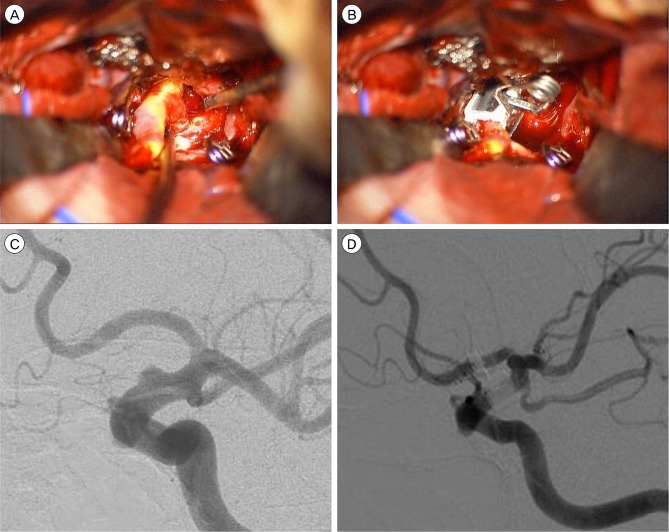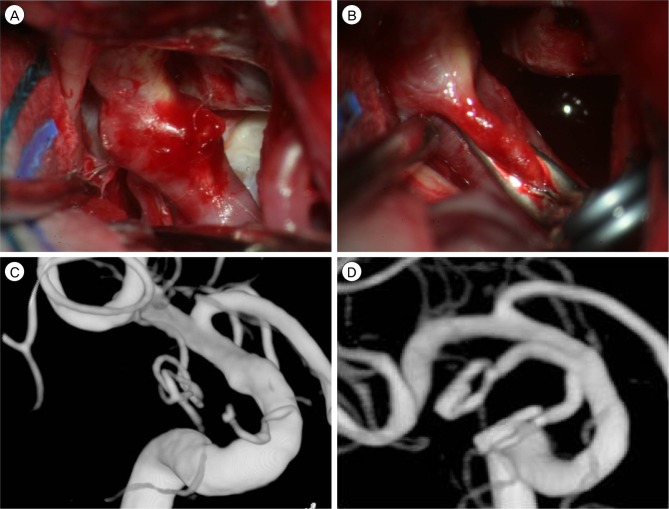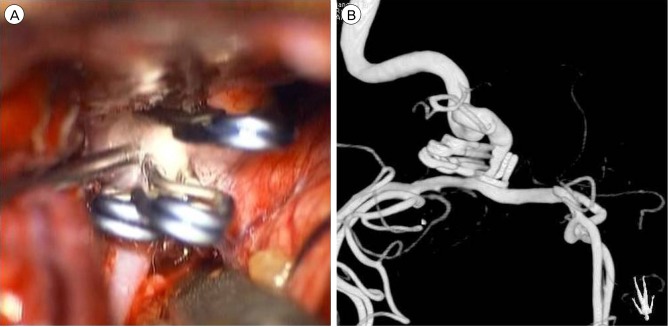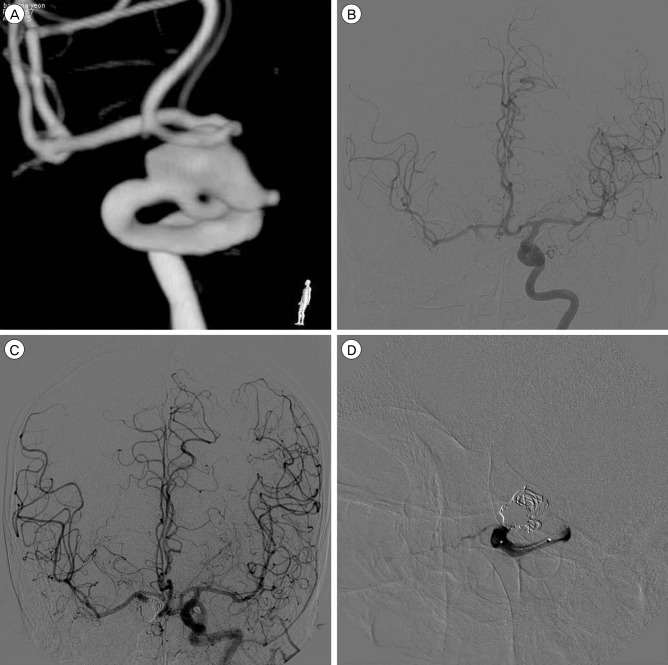J Cerebrovasc Endovasc Neurosurg.
2017 Sep;19(3):171-183. 10.7461/jcen.2017.19.3.171.
The Blood Blister Like-aneurysm: Usefulness of Sundt Clip
- Affiliations
-
- 1Department of Neurosurgery, Daegu Catholic University Hospital, Catholic University College of Medicine, Daegu, Korea. fhjhcho@cu.ac.kr
- KMID: 2393499
- DOI: http://doi.org/10.7461/jcen.2017.19.3.171
Abstract
OBJECTIVE
Blood blister-like aneurysm (BBA) is a kind of dorsal wall aneurysm and it is small, sessile, fragile and hazardous because of its high mortality and morbidity. Many challenges tried to establish the management or strategy. But so far, there is no optimal treatment of choice for the BBA. In this article, 17 cases of the ruptured BBA in one institute were analyzed retrospectively. The operative options were correlated with surgical and clinical outcomes.
MATERIALS AND METHODS
During 14 years between October, 2002 and October, 2016, 23 patients were treated for subarachnoid hemorrhage with ruptured dorsal wall aneurysms. There were various strategies for treatment and different outcomes revealed. BBA were 17 (74%) cases and 6 (26%) cases were saccular aneurysm. By excluding saccular aneurysm, BBA was sorted and classified with its morphological characteristics, and the outcome of treatment in each case investigated retrospectively.
RESULTS
Among 17 BBA-cases, 8 cases get microsurgical operation by Sundt clip. 5 cases get operation by conventional Yasargil clip, 1 case treated by Yasargil clip with wrapping, and 2 cases underwent endovascular management with coiling, and 1 case was managed by endovascular trapping of involved internal cerebral artery. Clinical outcomes were analyzed with modified Rankin Scale, Glasgow outcome scale and post-operative complications.
CONCLUSION
As the optimal management, operation using Sundt clip had much significance in treatment BBA. And, a thorough analysis of the angiography is essential to prepare for the treatment of BBA.
Keyword
MeSH Terms
Figure
Cited by 1 articles
-
Slip Clip after successful microsurgery of a blister aneurysm: Should bypass always be the first option?
Aline Lariessy Campos Paiva, Guilherme Brasileiro de Aguiar, Juan Antonio Castro Flores, José Carlos Esteves Veiga
J Cerebrovasc Endovasc Neurosurg. 2021;23(3):245-250. doi: 10.7461/jcen.2021.E2020.12.001.
Reference
-
1. Bojanowski MW, Weil AG, McLaughlin N, Chaalala C, Magro E, Fournier JY. Morphological aspects of blister aneurysms and nuances for surgical treatment. J Neurosurg. 2015; 11. 123(5):1156–1165. PMID: 26053352.
Article2. Cho JI, Cho JH. Use of the sundt clip graft in a previously coiled internal carotid artery blister-like aneurysm. J Korean Neurosurg Soc. 2014; 12. 56(6):496–499. PMID: 25628810.
Article3. Cho TG, Hwang SN, Nam TG, Park SW. Salvage surgical treatment for failed endovascular procedure of a blood blister-like aneurysm. J Cerebrovasc Endovasc Neurosurg. 2012; 6. 14(2):99–103. PMID: 23210036.
Article4. Choi JH, Kim TH, Park SK, Hwang YS, Shin HS, Shin JJ. Combination treatment for rapid growth of a saccular aneurysm on the internal carotid artery dorsal wall: case report. J Cerebrovasc Endovasc Neurosurg. 2014; 9. 16(3):303–308. PMID: 25340036.
Article5. Connolly ES Jr, Britz GW, Hongo K, Lawton MT, Meyer FB. Youmans & Winn Neurological surgery. Amsterdam, Netherlands: ELSEVIER;2017. p. 3313.6. Gaughen JR Jr, Hasan D, Dumont AS, Jensen ME, McKenzie J, Evans AJ. The efficacy of endovascular stenting in the treatment of supraclinoid internal carotid artery blister aneurysms using a stent-in-stent technique. AJNR Am J Neuroradiol. 2010; 6. 31(6):1132–1138. PMID: 20150303.
Article7. Hong CK, Ahn JY, Joo JY. Internal carotid artery trunk aneurysms - management and outcome. Korean J Cerebrovasc Surg. 2006; 6. 8(2):91–95.8. Joo SP, Kim TS, Moon KS, Kwak HJ, Lee JK, Kim JH, et al. Arterial suturing followed by clip reinforcement with circumferential wrapping for blister-like aneurysms of the internal carotid artery. Surg Neurol. 2006; 10. 66(4):424–428. PMID: 17015131.
Article9. Kim JS, Park SH, Hong CK, Huh JS, Kang HL, Joo JY. Cerebral bypass surgery for treating unclippable and uncoilable aneurysms. Korean J Cerebrovasc Surg. 2011; 9. 13(3):194–200.10. Kawashima A, Okada Y, Kawamata T, Onda H, Kubo O, Hori T. Successful treatment of a blood blister-like aneurysm of the internal carotid artery by trapping with a high-flow bypass. J Clin Neurosci. 2008; 7. 15(7):797–800. PMID: 18406147.
Article11. Korja M, Rautio R, Valtonen S, Haapanen A. Primary treatment of ruptured blood blister-like aneurysms with stent-assisted coil embolization: report of two cases. Acta Radiol. 2008; 3. 49(2):180–183. PMID: 18300143.
Article12. Lee CC, Hsieh TC, Wang YC, Lo LY, Lee ST, Yang TC. Ruptured symptomatic internal carotid artery dorsal wall aneurysm with rapid configurational change. Clinical experience and management outcome: an original article. Eur J Neurol. 2010; 10. 17(10):1277–1284. PMID: 20831774.
Article13. Başkaya MK, Ahmed AS, Ateş O, Niemann D. Surgical treatment of blood blister-like aneurysms of the supraclinoid internal carotid artery with extracranial-intracranial bypass and trapping. Neurosurg Focus. 2008; 24(2):E13.
Article14. Owen CM, Montemurro N, Lawton MT. Blister aneurysms of the internal carotid artery. Neurosurgery. 2017; 2. 80(2):235–247. PMID: 28173470.15. Park JH, Park IS, Han DH, Kim SH, Oh CW, Kim JE, et al. Endovascular treatment of blood blister-like aneurysms of the internal carotid artery. J Neurosurg. 2007; 5. 106(5):812–819. PMID: 17542524.
Article16. Park PJ, Meyer FB. The Sundt clip graft. Neurosurgery. 2010; 6. 66(6 Suppl Operative):300–305. discussion 305. PMID: 20489520.
Article17. Shimizu H, Matsumoto Y, Tominaga T. Non-saccular aneurysms of the supraclinoid internal carotid artery trunk causing subarachnoid hemorrhage: acute surgical treatments and review of literatures. Neurosurg Rev. 2010; 4. 33(2):205–216. PMID: 20521339.
Article18. Tekkök IH, Bakar B. Ruptured blister-like aneurysm of distal internal carotid artery: a distinct entity. Turk Neurosurg. 2008; 10. 18(4):439–445. PMID: 19107697.
- Full Text Links
- Actions
-
Cited
- CITED
-
- Close
- Share
- Similar articles
-
- Use of the Sundt Clip Graft in a Previously Coiled Internal Carotid Artery Blister-Like Aneurysm
- The Sundt Encircling Clip as a Vascular Rescue: A Case Report and a Review of Repair Methods for Arterial Tearing
- Salvage Surgical Treatment for Failed Endovascular Procedure of a Blood Blister-Like Aneurysm
- Direct Repair of a Dorsal Wall Aneurysm on Supraclinoid Internal Carotid Artery
- Blood Blister-Like Aneurysm with Rupture Point Close to Origin of Anterior Choroidal Artery





